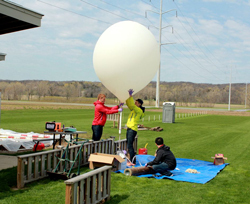Undergraduate Solar Cell Project Takes Flight
Students send solar cell high into the atmosphere attached to a weather balloon
When McCormick students have a question, they’ll go to great lengths to find the answer.
In the case of four seniors, it was “great heights” — 97,000 feet, to be precise.
The project began with Mark Fischer, a senior studying mechanical engineering at the McCormick School of Engineering, who was curious how solar cells behave at high altitudes. Common sense would suggest they would be more effective — a closer proximity to the sun would mean more intense rays — but is this true? The answer could be important for future technologies like solar-powered aircraft and drones.
Laying the Groundwork
Fischer is a member of the Murphy Institute, a program that invites select McCormick undergraduates to engage in self-directed activities. For his Murphy Institute project, he decided to use a weather balloon to carry a solar cell and a variety of sensors high into the atmosphere to collect data on temperature, solar irradiance, and solar cell power output.
The idea seemed simple. After collecting the data, the balloon would burst due to low atmospheric pressure, and a five-foot parachute would carry the devices safely back to earth. A video camera affixed to the payload would record the trip, and a special GPS unit designed to operate at high altitudes would track the payload so it could be recovered. The GPS data would even be broadcast live on the Internet.
The devices would encounter extreme conditions: at an altitude above 99.9 percent of the atmosphere — and in temperatures of -50 degrees Celsius — the 7-foot balloon would swell to 31 feet before bursting and dropping to the ground.
“I initially thought it wasn’t going to be too hard.” Fischer said. “After all, it’s just a big balloon and a box of electronics, right?”
Fischer brought on three friends to lend their talents: Julian Minuzzo, a senior studying materials science; Jingwei Lou, a fellow Murphy Scholar majoring in mechanical engineering; and Sail Wu, a Murphy Scholar studying industrial engineering and applied math at McCormick and pursuing an undergraduate certificate at the Kellogg School of Management.
Into the Air
Each student took on his own part of the project. Fischer was responsible for the payload’s structural design and the GPS unit. Minuzzo — who recently won the 2013 Gotaas Award for his work with self-assembled solar cells — engineered the solar cell and figured out how to best fill the weather balloon with helium. Lou handled the data acquisition system, sensors that measured the air temperature, intensity of the sun’s rays, and the voltage of the solar cell. Wu would analyze the data after the flight.
 In April, the team traveled 160 miles southwest of Evanston to a field in Peoria, Illinois, for their first flight attempt. The students measured the balloon’s lift force and ran predictions to measure its predicted altitude and trajectory. Despite gusting wind, the team got the balloon into the air, where it lifted to 80,000 feet and traveled 180 miles before the payload touched down.
In April, the team traveled 160 miles southwest of Evanston to a field in Peoria, Illinois, for their first flight attempt. The students measured the balloon’s lift force and ran predictions to measure its predicted altitude and trajectory. Despite gusting wind, the team got the balloon into the air, where it lifted to 80,000 feet and traveled 180 miles before the payload touched down.
But during the flight, the data acquisition system failed. Returning to campus that day, the team had learned some valuable lessons. “Managing the balloon was much more challenging than we expected, especially in windy conditions,” Fischer said.
After making some tweaks, the team launched again on May 23 in Hobart, Indiana. Gentler wind and more helium made the conditions more favorable, and this time the launch was a success. The balloon soared to 97,000 feet and traveled 40 miles before the payload was recovered intact.
A Surprising Result
When they crunched the numbers, the students were surprised by the findings. The solar cell did not perform best at the highest altitudes; instead, its performance peaked between 50,000 and 60,000 feet.
“Solar cells are more efficient as they get colder,” explained Minuzzo. “As altitude increases, the air temperature gets colder, but then you reach a point where it gets warmer again. The air is coldest between 50,000 and 60,000 feet.”
A full year in the making, the project was a great learning experience for the students — not just about solar cells or weather balloons, but the value of careful preparation.
“There’s this moment where you count down — 3, 2, 1 — and let the balloon go, and there’s nothing you can do. It’s out of your hands,” Fischer said. “You launch it and cross your fingers and hope you did everything right.”
All that preparation won’t go to waste. The students are in talks with Northwestern professors who are interested in conducting their own high-altitude research with the balloon.